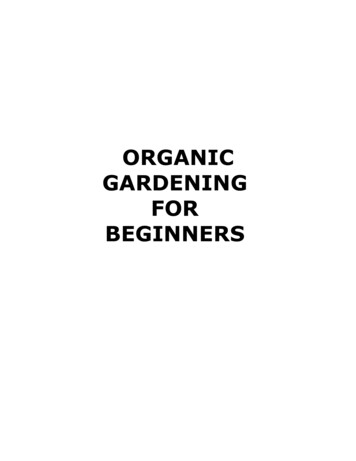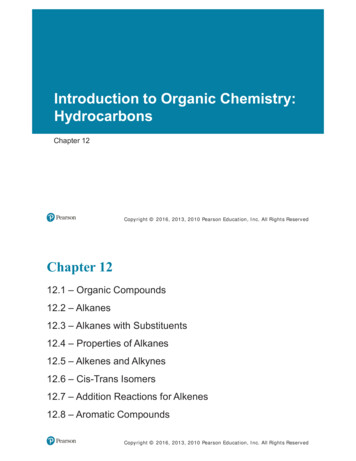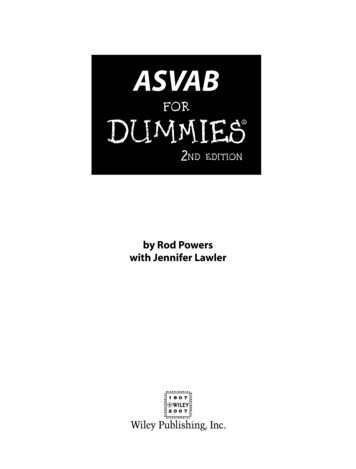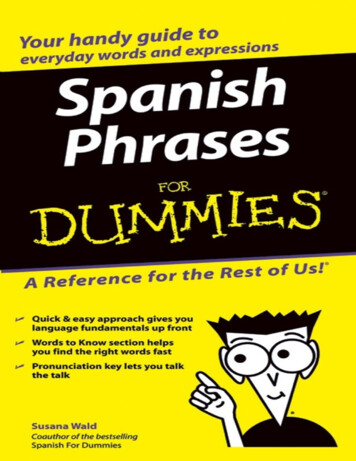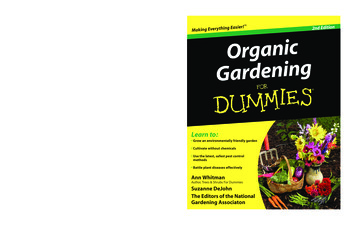
Transcription
spine .768”Gardening/OrganicWant to grow an organic garden? This guide shows youhow. From maintaining your lawn and choosing problemfree plants to growing hearty fruits and vegetables, you’lldiscover how to stay organic year-round and reduce yourgarden’s impact on both the environment and your wallet. New to this edition — learn about the latest natural fertilizers,pest control methods, equipment, and gardening resources Is organic right for you? — understand the basic concepts oforganic gardening and plan a low-maintenance landscape It all starts with the soil — test your soil, make compost, andnurture the underground ecosystem that helps your plants thrive Deal with pesky pests — from weeds to bugs to diseases,discover the specific control measures and products for organicpest management Food, glorious food — grow the freshest, tastiest, and mostnutritious fruits, vegetables, herbs, and nuts Open the book and find: The benefits of gardeningorganically Hands-on tips for gardeners at alllevels Color photos of successful organicgardening practices Guidance in building andmaintaining healthy soil An overview of pest-controlproducts Inspirational tips for makingeco-conscious decisions Ways to attract helpful insects andother organisms Ten ways to have an eco-friendlylandscapecinagrOgninedGarLearn to:Go to dummies.comfor more! Grow an environmentally friendly garden Cultivate without chemicals Use the latest, safest pest controlmethods Battle plant diseases effectivelyAnn Whitman is the author of the first edition of Organic Gardening ForDummies. Suzanne DeJohn is an editor with the National GardeningAssociation, the leading garden-based educational nonprofitorganization in the U.S. NGA’s programs and initiatives highlight theopportunities for plant-based education in schools, communities, andbackyards across the country. These include award-winning Web sitesgarden.org and kidsgardening.org.2nd Edition2nd EditionOrganic GardeningEnsure a healthy harvestthrough environmentally friendlygardening techniques.g Easier!Making EverythinAnn Whitman 19.99 US / 23.99 CN / 13.99 UKAuthor, Trees & Shrubs For DummiesISBN ociationSuzanne DeJohnThe Editors of the NationalGardening Associaton
OrganicGardeningFORDUMmIES‰2NDEDITION
OrganicGardeningFORDUMmIES‰2NDEDITIONby Ann Whitman, Suzanne DeJohn,The Editors of the National Gardening Association01 430675-ffirs.indd iii2/6/09 5:30:30 PM
Organic Gardening For Dummies , 2nd EditionPublished byWiley Publishing, Inc.111 River St.Hoboken, NJ 07030-5774www.wiley.comCopyright 2009 by Wiley Publishing, Inc., Indianapolis, IndianaPublished simultaneously in CanadaNo part of this publication may be reproduced, stored in a retrieval system, or transmitted in any formor by any means, electronic, mechanical, photocopying, recording, scanning, or otherwise, except aspermitted under Sections 107 or 108 of the 1976 United States Copyright Act, without either the priorwritten permission of the Publisher, or authorization through payment of the appropriate per-copy fee tothe Copyright Clearance Center, 222 Rosewood Drive, Danvers, MA 01923, 978-750-8400, fax 978-646-8600.Requests to the Publisher for permission should be addressed to the Permissions Department, John Wiley& Sons, Inc., 111 River Street, Hoboken, NJ 07030, 201-748-6011, fax 201-748-6008, or online at http://www.wiley.com/go/permissions.Trademarks: Wiley, the Wiley Publishing logo, For Dummies, the Dummies Man logo, A Reference for theRest of Us!, The Dummies Way, Dummies Daily, The Fun and Easy Way, Dummies.com, Making EverythingEasier, and related trade dress are trademarks or registered trademarks of John Wiley & Sons, Inc. and/or its affiliates in the United States and other countries, and may not be used without written permission.All other trademarks are the property of their respective owners. Wiley Publishing, Inc., is not associatedwith any product or vendor mentioned in this book.LIMIT OF LIABILITY/DISCLAIMER OF WARRANTY: THE PUBLISHER AND THE AUTHOR MAKE NOREPRESENTATIONS OR WARRANTIES WITH RESPECT TO THE ACCURACY OR COMPLETENESS OFTHE CONTENTS OF THIS WORK AND SPECIFICALLY DISCLAIM ALL WARRANTIES, INCLUDING WITHOUT LIMITATION WARRANTIES OF FITNESS FOR A PARTICULAR PURPOSE. NO WARRANTY MAY BECREATED OR EXTENDED BY SALES OR PROMOTIONAL MATERIALS. THE ADVICE AND STRATEGIESCONTAINED HEREIN MAY NOT BE SUITABLE FOR EVERY SITUATION. THIS WORK IS SOLD WITH THEUNDERSTANDING THAT THE PUBLISHER IS NOT ENGAGED IN RENDERING LEGAL, ACCOUNTING, OROTHER PROFESSIONAL SERVICES. IF PROFESSIONAL ASSISTANCE IS REQUIRED, THE SERVICES OFA COMPETENT PROFESSIONAL PERSON SHOULD BE SOUGHT. NEITHER THE PUBLISHER NOR THEAUTHOR SHALL BE LIABLE FOR DAMAGES ARISING HEREFROM. THE FACT THAT AN ORGANIZATION OR WEBSITE IS REFERRED TO IN THIS WORK AS A CITATION AND/OR A POTENTIAL SOURCEOF FURTHER INFORMATION DOES NOT MEAN THAT THE AUTHOR OR THE PUBLISHER ENDORSESTHE INFORMATION THE ORGANIZATION OR WEBSITE MAY PROVIDE OR RECOMMENDATIONS ITMAY MAKE. FURTHER, READERS SHOULD BE AWARE THAT INTERNET WEBSITES LISTED IN THISWORK MAY HAVE CHANGED OR DISAPPEARED BETWEEN WHEN THIS WORK WAS WRITTEN ANDWHEN IT IS READ.For general information on our other products and services, please contact our Customer CareDepartment within the U.S. at 877-762-2974, outside the U.S. at 317-572-3993, or fax 317-572-4002.For technical support, please visit www.wiley.com/techsupport.Wiley also publishes its books in a variety of electronic formats. Some content that appears in print maynot be available in electronic books.Library of Congress Control Number: 2009920904ISBN: 978-0-470-43067-5Manufactured in the United States of America. This book is printed on recycled paper.10 9 8 7 6 5 4 3 2 1
About the AuthorsSuzanne DeJohn describes her fascination with all things botanical asencompassing a curiosity about the natural world and a passion for the science that explains what she sees, all wrapped up in an aesthetic sensibilitythat inspires her to find beauty in the simplest expressions of nature. “Asgardeners, we must take our cues from nature and follow the principles thatgovern healthy ecosystems. It’s the only way we can create an environmentthat can sustain us now and for generations to come.”Suzanne has worn a variety of hats in her twelve years with the NationalGardening Association, including work in the education, editorial, and ITdepartments. She coordinated NGA’s online question and answer servicefor six years and has answered literally thousands of gardening questions.Convinced that gardeners are curious and love to learn, she was inspired tocreate the Exploring the Garden series of in-depth, online courses that teachthe principles of botany in the context of the garden. Suzanne also does Weband print-based graphic design work for NGA, takes photos for the Web sites,and creates illustrations to accompany articles.Suzanne’s varied background includes a BS in geology from Tufts; universitycourses in botany, soils, and plant pathology; a stint as a research assistantin plant pathology; and several years as a self-employed artist and graphicdesigner. She’s worked on a landscape crew, as well as on a dairy farm andan organic vegetable farm, and spent several years as a cook at a naturalfoods store. The common themes running through these seemingly disparatevocations are plants, beauty, nature, and healthy food. Suzanne strives forbalance in her life by combining time spent outdoors in her gardens withtime spent at the computer, communicating what she has learned aboutplants and gardening.Ann Whitman earned a Bachelor of Science degree in Plant and Soil Scienceat the University of Vermont. She also completed a Master of Arts degreein Landscape Design from the Conway School of Landscape Design inMassachusetts. Ann is the author of Trees and Shrubs For Dummies (WileyPublishing, Inc.) as well as How-To Landscaping Basics and Water Gardens:Simple Steps to Adding the Beauty of Water to Your Garden, both publishedby Time Life. She also contributes to several gardening magazines and Websites. When she’s not writing, Ann gardens on fertile river-bottom soil inVermont where the winters are long and the summers are short, but worth it.
The National Gardening Association (NGA) is committed to sustainingand renewing the fundamental links between people, plants, and the earth.Founded in 1972 as “Gardens for All” to spearhead the community gardenmovement, today’s NGA promotes environmental responsibility, advancesmultidisciplinary learning and scientific literacy, and creates partnershipsthat restore and enhance communities.NGA is best known for its garden-based curricula, educational journals, international initiatives, and several youth garden grant programs. Together thesereach more than 300,000 children nationwide each year. NGA’s Web sites,one for home gardeners and another for those who garden with kids, buildcommunity and offer a wealth of custom content.To find out more about the National Gardening Association, write to 1100Dorset St., South Burlington, VT 05403, or visit its Web site at www.garden.org or www.kidsgardening.com.
DedicationSuzanne dedicates this book to her husband, Dale Lane. “Your wisdom,integrity, generosity, and love inspire me every day.”
AcknowledgmentsSuzanne would like to thanks Ann Whitman for her incredible work on thefirst edition of this book. It was an honor, a pleasure, and a challenge torevise — and attempt to improve upon -— a book that was so filled withuseful information. A big round of applause goes to Tracy Barr, the projecteditor whose insights greatly improved the organization, clarity, and usability of the book. I’m in awe of the way she kept everyone and everythingorganized. Thanks, too, to Kathy Simpson, another editor who helped focusmy wandering prose, and technical editor David King for scrutinizing the content. Finally, thank you to the National Gardening Association for the opportunity to write about organic gardening, a subject near and dear to my heart.
Publisher’s AcknowledgmentsWe’re proud of this book; please send us your comments through our Dummies online registration form located at http://dummies.custhelp.com. For other comments, please contact ourCustomer Care Department within the U.S. at 877-762-2974, outside the U.S. at 317-572-3993, or fax317-572-4002.Some of the people who helped bring this book to market include the following:Acquisitions, Editorial, and MediaDevelopmentProject Editor: Tracy BarrComposition ServicesProject Coordinator: Patrick Redmond(Previous Edition: Tere Drenth)Layout and Graphics: Reuben W. Davis,Christin Swinford, Christine WilliamsAcquisitions Editor: Stacy KennedySpecial Art: Kathryn BornCopy Editor: Kathy SimpsonAssistant Editor: Erin Calligan MooneyProofreaders: Laura L. Bowman,Jessica KramerEditorial Program Coordinator: Joe NiesenIndexer: Potomac Indexing, LLCTechnical Editor: David KingSenior Editorial Manager: Jennifer EhrlichEditorial Supervisor and Reprint Editor:Carmen KrikorianEditorial Assistant: Jennette ElNaggarCover Photos: The National GardeningAssociationCartoons: Rich Tennant(www.the5thwave.com)Publishing and Editorial for Consumer DummiesDiane Graves Steele, Vice President and Publisher, Consumer DummiesKristin Ferguson-Wagstaffe, Product Development Director, Consumer DummiesEnsley Eikenburg, Associate Publisher, TravelKelly Regan, Editorial Director, TravelPublishing for Technology DummiesAndy Cummings, Vice President and Publisher, Dummies Technology/General UserComposition ServicesGerry Fahey, Vice President of Production ServicesDebbie Stailey, Director of Composition Services
Contents at a GlanceIntroduction . 1Part I: Understanding the Basicsof Organic Gardening . 5Chapter 1: Basic Techniques in Organic Gardening. 7Chapter 2: Why Garden Organically? . 17Chapter 3: Planning Your Organic Landscape . 29Part II: Soil and Fertilizers . 49Chapter 4: Digging beneath the Surface: Soils 101 . 51Chapter 5: Building Healthy Soil . 61Chapter 6: Using Organic Fertilizers . 81Part III: Managing Pests . 93Chapter 7: Pest Control and Pesticide Safety 101. 95Chapter 8: Managing Insect Pests . 115Chapter 9: Battling Plant Diseases . 141Chapter 10: Outwitting Critters. 159Part IV: Growing Organically in Your Yardand Garden . 181Chapter 11: Weed It and Reap! . 169Chapter 12: Planting How-To . 183Chapter 13: Raising Organic Vegetables . 197Chapter 14: Herbs for the Home and Garden . 221Chapter 15: Picking from the Berry Patch . 233Chapter 16: Fruits and Nuts for Your Organic Orchard. 247Chapter 17: Say It with Flowers. 267Chapter 18: Run for the Roses. 281Chapter 19: Managing Landscape Trees and Shrubs . 295Chapter 20: Caring for Your Organic Lawn . 313Part V: The Part of Tens . 331Chapter 21: Ten Best Organic Gardening Practices . 333Chapter 22: Ten Ways to Be Eco-Friendly . 337Index . 340
Table of ContentsIntroduction . 1About This Book . 1Conventions Used in This Book . 1What You’re Not to Read . 2Foolish Assumptions . 2How This Book Is Organized . 3Part I: Understanding the Basics of Organic Gardening . 3Part II: Soil and Fertilizers . 3Part III: Managing Pests . 3Part IV: Growing Organically in Your Yard and Garden . 3Part V: The Part of Tens . 3Color photo section . 4Icons Used in This Book . 4Where to Go from Here . 4Part I: Understanding the Basics of Organic Gardening . 5Chapter 1: Basic Techniques in Organic Gardening . . . . . . . . . . . . . . . .7Defining Organic Gardening . 7Building Soil. 8Planting Wisely . 9Ensuring diversity of plant types . 10Encouraging animal and insect diversity. 11Using Integrated Pest Management. 12Managing Nutrients . 14Conserving Inputs. 14Water . 15Consider the source . 15Chapter 2: Why Garden Organically? . . . . . . . . . . . . . . . . . . . . . . . . . . . .17Organic Growing for Your Health . 17Alternative to synthetic pesticides. 18More nutrients in organically grown foods . 19Fewer genetically modified organisms . 20Organic Growing for the Environment. 21Protecting wildlife . 21Helping pollinators . 22Minimizing water contamination . 23Preventing erosion. 24Conserving water . 24
xivOrganic Gardening For Dummies, 2nd EditionWhat Constitutes “Organic”? The U.S. Government Gets Involved . 25The Organic Foods Production Act . 25New trends in the organic movement . 26Chapter 3: Planning Your Organic Landscape . . . . . . . . . . . . . . . . . . . .29Factors Affecting Your Design Decisions . 29Life cycles: Annual, biennial, and perennial . 29Deciduous, evergreen, and conifer . 30Type of leaves, flowers, and roots . 31Plant shapes . 33Plant cold and heat hardiness. 34Knowing Your Landscape Conditions. 35Considering your region’s climate. 35Thinking about your microclimates . 38Getting Started on Your Garden Design . 41Basic design principles for your garden . 42Types of landscape arrangements. 43Putting pencil to paper. 45Making a map . 45Putting it all together. 47Part II: Soil and Fertilizers . 49Chapter 4: Digging beneath the Surface: Soils 101 . . . . . . . . . . . . . . . .51Soil Components: The Nitty-Gritty . 51Digging into the Topsoil. 53Composition of soil . 54Soil structure . 55Starting from Fertile Ground . 56Amount of nutrients in the soil . 57Soil particles . 58Organic matter . 58Soil pH . 59Chapter 5: Building Healthy Soil . . . . . . . . . . . . . . . . . . . . . . . . . . . . . . . .61Knowing Your Soil . 61Testing your soil type: Sand, silt, or clay? . 62Testing for drainage . 63Testing for pH and nutrients . 63Adding Organic Matter: The Soul of the Soil . 66Dung ho! . 67Green manures and cover crops. 68Compost: The prince of organic matter . 70
Table of ContentsCompost Happens: Making Your Own . 71Getting your compost pile started. 72Keepin’ it cookin’ . 73Choosing materials to compost . 74Maintaining proper ratios . 75Turning Your Soil . 76No-till gardening . 77Raised beds. 78Chapter 6: Using Organic Fertilizers. . . . . . . . . . . . . . . . . . . . . . . . . . . . .81Fertilizers 101 . 81Organic versus synthetic fertilizers . 82Fast release versus slow release . 83The big three . 83Secondary nutrients . 85Micronutrients . 86Application methods . 86Types of Organic Fertilizers . 87Plant-based fertilizers. 87Animal-based fertilizers . 89Rock on with mineral-based fertilizers . 90Finding a Sustainable Source . 92Part III: Managing Pests . 93Chapter 7: Pest Control and Pesticide Safety 101 . . . . . . . . . . . . . . . . .95Dealing with Pests the Organic Way: Integrated Pest Management . 95Start with pest-resistant plants . 96Make the garden less inviting to pests. 97Identify culprits . 99Establish thresholds . 100Choose a control method . 101The Benefits of Beneficials . 102Identifying beneficial insects . 102Attracting beneficial insects . 107Encouraging other insect predators . 108Using Pesticides Safely . 110Types of pesticides . 110Active versus inert ingredients . 111Pesticide toxicity . 111Protecting yourself, the plants, and the environment . 112Keeping records . 114xv
xviOrganic Gardening For Dummies, 2nd EditionChapter 8: Managing Insect Pests . . . . . . . . . . . . . . . . . . . . . . . . . . . . .115Understanding Insects . 115Managing Insect Pests. 116Removing pests manually . 117Barriers, repellents, and traps . 118Repellents . 120Traps . 120Biological controls . 121Soap and oil sprays. 123Botanicals: Plant-based insecticides . 125A Quick Guide to Getting Rid of Common Pests . 126Chapter 9: Battling Plant Diseases . . . . . . . . . . . . . . . . . . . . . . . . . . . . .141What’s Wrong with My Plant? . 141Understanding Plant Diseases . 142The fungus among us . 142Bacteria and viruses . 143Preventing Problems . 144Making wise plant selections. 144Keeping plants dry and mulched . 144Other ways to prevent disease . 145Disease-Control Techniques and Products . 146Curing Common Garden Diseases . 148Rooting Out Environmental Problems . 154Air pollution and ozone. 155Herbicide injury . 155Lawn-mower and string-trimmer damage . 155Leaf scorch . 155Nutrient deficiency . 156Salt damage. 156Winter and frost injury . 157Woodpecker holes . 158Chapter 10: Outwitting Critters . . . . . . . . . . . . . . . . . . . . . . . . . . . . . . . .159Oh, Deer! . 159Identifying deer damage. 160Keeping deer out of your garden . 160Wascally Wabbits . 162Groundhogs . 164Gophers . 165Mice and Voles . 165Moles and Skunks . 166Squirrels.
Guidanc e in building and maintaining healthy soil An overview of pest-control products Inspirational tips for making eco-conscious decisions W ays to attract helpful insects and other organisms Ten ways to have an eco-friendly landscape Ann Whitman is the author of the first edition of Organic Gardening For Dummies.

